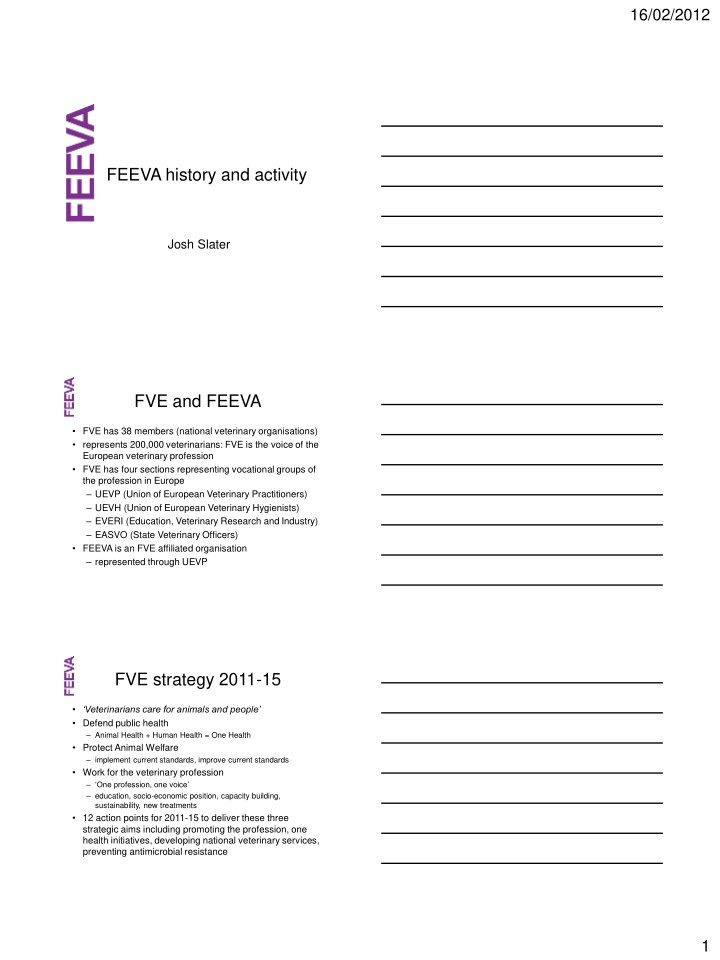



16/02/2012 FEEVA history and activity Josh Slater FVE and FEEVA • FVE has 38 members (national veterinary organisations) • represents 200,000 veterinarians: FVE is the voice of the European veterinary profession • FVE has four sections representing vocational groups of the profession in Europe – UEVP (Union of European Veterinary Practitioners) – UEVH (Union of European Veterinary Hygienists) – EVERI (Education, Veterinary Research and Industry) – EASVO (State Veterinary Officers) • FEEVA is an FVE affiliated organisation – represented through UEVP FVE strategy 2011-15 • ‘Veterinarians care for animals and people’ • Defend public health – Animal Health + Human Health = One Health • Protect Animal Welfare – implement current standards, improve current standards • Work for the veterinary profession – ‘One profession, one voice’ – education, socio-economic position, capacity building, sustainability, new treatments • 12 action points for 2011-15 to deliver these three strategic aims including promoting the profession, one health initiatives, developing national veterinary services, preventing antimicrobial resistance 1
16/02/2012 FEEVA history • established in 1997/1998 (first meeting in Strasbourg) • availability of equine medicines • equine health and welfare; safeguard public health • main focus medicines, transport and identification • currently represented on FVE working groups on medicines (Josh Slater) and transport (Istvan Soos) • Medicines – 1950/2006/EC (Essentials List) – 470/2009/EC (amendment to MRL regulation 2001/82/EC) • Transport – 1/2005/EC and declaration 0049/2011 FEEVA history • Henk Vaarkamp and Willem Back were initial driving forces • FEEVA presidents – 1999-2003 Willem Back (Netherlands) - Founding President – 2003-2005 Jacques Bardiès (France) – 2005-2007 Alistair Barr (UK) – 2007-2009 Joe Collins (Ireland) – 2009-2011 Josh Slater (UK) • Current Board – Josh Slater (President) – Jesper Moeller Nielson (Secretary) – Erik Gostelie (Treasurer) – Orsolya Kutasi (Board member) – Vivienne Duggan (Board member) – Miguel Llorca (Board member) FEEVA Statutes • Foundation and purposes – Representation of members – Promote equine veterinary profession – Harmonisation of legislation – Harmonisation of disease prevention – Consult on European Directives, Regulations & Decisions and provide expert opinion on equine veterinary matters – Promote liaison between organisations – Promote scientific exchange • Work closely with FVE, support FVE, complement FVE – ‘One profession, One voice’ 2
16/02/2012 FEEVA activities 2010-11 • FVE Transport working group – Transport Forum; Codes of Practice • FVE Medicines working group – Essentials List (470/2009) – Antimicrobials: responsible use and prescribing guides • Position statements – change of status of the horse • European Acknowledged Veterinarians (EBVPD) • Engagement with other networks and professionals – CALLISTO – European Horse Network – other healthcare providers to the horse CALLISTO • Companion Animals Multisectorial Interprofessional and Interdisciplinary Strategic Think Tank on Zoonoses • Seventh Framework Programme • 3 year project focussing on zoonotic risks from companion animals; start date January 2012 • CALLISTO project goals: – provide overview of current situation – identify knowledge and technology gaps for main zoonoses – produce targeted actions to reduce risk from zoonoses • delivered by 7 Expert Advisory Groups (Viral, Bacterial, Parasitic, Epi, Social & Welfare, Users, Policy) European Federation of Farriers Associations (EFFA) 3
16/02/2012 Certified Euro-Farrier • common basic standard of competence in farriery • promote equine welfare through high standards of trimming and shoeing • standards developed through an EC Leonardo da Vinci project • C-EF scheme – recognises those with required competence – requires completion of a course of training and passing an examination – provides means of identifying properly trained farriers in all countries – encourages countries without formal qualifications to raise standards to meet those of EFFA EFFA proposal for a M.o.U The Federation of European Equine Veterinary Associations and the European Federation of Farriers Associations agree to work together for the purposes of: • Improving the welfare of the horse by encouraging the highest standards of hoof trimming and shoeing • Encouraging close working between farriers and veterinary surgeons on the therapeutic treatment of horses’ hooves • Encouraging the education of the horse owning public in relation to the art and science of farriery Background note: farriers are included in Annex IV (trades) of 2005/36/EC (recognition of professional qualifications) but consider Annex II (healthcare) more appropriate European Horse Network 4
16/02/2012 EHN purpose • Promote development of European horse industry • Increase visibility and impact through coordination • Platform for communication to media and regulators • Exchange views on political developments • Political lobbying for the horse industry • Identify areas of common interest EHN members • 12 member organisations – FEI – EEF (European Equestrian Federation) – IFHA (Horseracing Authorities) – ESSA (studs) – EFTBA (Thoroughbred Breeders – FEIF (Icelandic Horse Association) – HNS (Swedish Horse Council) – PFE (European Equestrian Regions) – UET (Trotting) – WBFSH (World Federation of Sport Horse Breeders) – FECTU (Draught Horse Federation) – EPMA (Insurers) VEATS (Voluntary Equine Animals trading Scheme) 5
Recommend
More recommend